|
Itís possible to fold the same strip in different ways
to create flexagons that behave differently.
Square Flexagon
The first example is for 8-sided tetraflexagons. Click on the following strip
to get a larger version and print two copies of it. Connect the two strips
together to make a zigzagging strip of 16 squares. Crease all the edges before
making the flexagon. Fold each 8 on the adjacent 8. Continue with 3 on 3, 2 on 2,
1 on 1, 7 on 7 and 4 on 4. You should end up with all the 5ís on one side and
the 6ís on the other. Connect the two squares with the remaining flaps.
Do the same with the second strip, but fold in the following order:
7, 3, 5, 2 and 8. Then fold the adjacent 4ís together and tuck one end
of the strip under the other so the 4ís are against each other. This should
leave the 1ís and 6ís on the outside and make it easy to connect the flaps together.
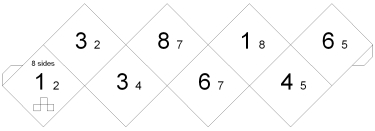
|
When exploring these flexagons, youíll need to use two different types of flexes
to be able to reach all the sides. One method is to simply fold the flexagon in
half and unfold it from the other side. The other is the ďbox flexĒ. You can try
this out on the second flexagon by starting from face 6 when the 1ís are on the
other side. Fold it in half either direction, leaving the 6ís on the outside.
You should be able to open the center of the flexagon, with hinges on the top and
bottom as well as left and right, leaving you with an open box. If you continue
folding it till itís lying flat again, you should be able to simply unfold it to
see either side 5 or 7, depending on which way you folded it originally.
The following graphs illustrate the different behavior of these two flexagons.
1/2 means that one side has all 1ís and the other has all 2ís. Solid lines
represent a simple fold flex to get between two states. The box flex is represented
by a dashed line. Sometimes when you fold it in half, you may be able to use either
a simple flex or box flex to get to another state. I represent this middle state by
only showing a single number in the graph with simple flexes and box flexes leading
from it.
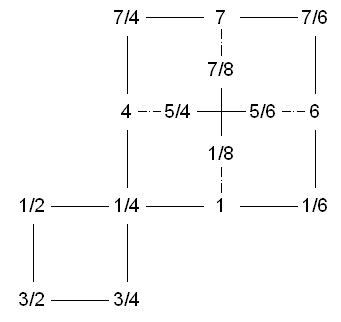
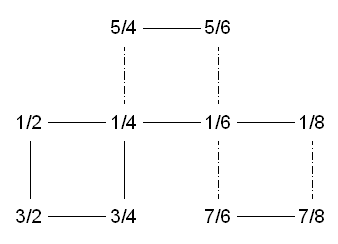
Here's a list of alternate numberings for the above strip:
- 1/2, 3/2, 3/4, 8/7, 8/1, 7/6, 4/5, 6/5
- 1/2, 3/2, 3/4, 8/7, 6/7, 1/8, 4/5, 6/5
- 1/2, 8/7, 8/1, 5/4, 6/7, 6/5, 2/3, 4/3
- 1/2, 3/2, 7/8, 7/6, 8/1, 5/4, 3/4, 6/5
- 1/2, 3/2, 8/1, 5/4, 3/4, 8/7, 5/6, 7/6
Pentagon Flexagon
Hereís another example using a 10-sided pentagon flexagon. Proceed in the same
way as with the tetraflexagons. Connect two copies of the strip and pre-crease
the edges. Start by folding all the even numbers together Ė 2 on 2, 4 on 4, 6 on 6,
8 on 8 and 10 on 10. Then fold 9 on 9, 7 on 7 and 5 on 5. Thisíll leave you with a
strip with 1ís on one side and the 3ís on the other. Fold it in half, leaving only
1ís on the outside, and connect the flaps.

|

|
Pentagon flexagons are similar to tetraflexagons but have a few differences. The
most notable is that it doesnít lie flat in the main position, which looks a bit like
a butterfly. The basic flex still works the same, however. Fold it in half then
unfold it from the other side. You can also do a box flex from some positions. One
additional move is the ďsnap flex.Ē When youíre in the main position with alternate
pentagons tilting up and down, you can push down on the center to snap it through so
the pentagons swap how theyíre tilted. This allows you to fold the flexagon in half
the other direction. This is only needed in the second flexagon to switch between
the two cycles reachable from 1/5.
Here are the state diagrams for the two flexagons above.
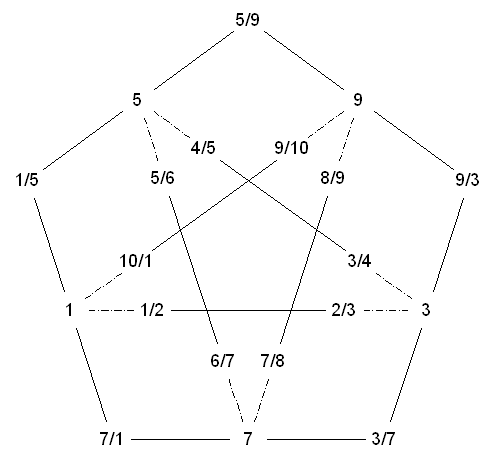
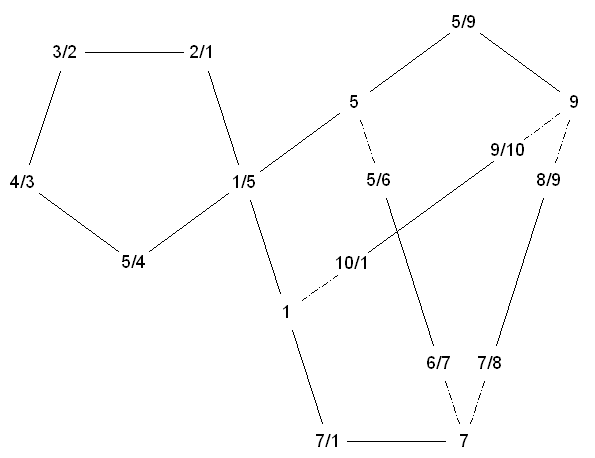
Here's a list of alternate numberings for the above strip:
- 1/2, 3/2, 9/10, 1/10, 7/8, 9/8, 5/6, 7/6, 3/4, 5/4
- 1/2, 3/2, 3/4, 5/4, 9/10, 1/10, 7/8, 9/8, 5/6, 7/6
- 1/2, 3/2, 9/10, 1/10, 5/6, 7/6, 8/9, 8/7, 3/4, 5/4
- 1/2, 3/2, 3/4, 5/4, 9/10, 9/8, 10/1, 7/6, 5/6, 8/7
- 1/2, 3/2, 3/4, 5/4, 9/10, 9/8, 7/8, 1/10, 5/6, 7/6
- 1/2, 3/2, 3/4, 5/4, 8/9, 1/10, 7/8, 10/9, 5/6, 7/6
- 1/2, 3/2, 3/4, 10/9, 8/9, 1/10, 7/8, 6/5, 4/5, 7/6
- 1/2, 3/2, 3/4, 9/8, 9/10, 1/10, 7/8, 5/4, 5/6, 7/6
- 1/2, 3/2, 3/4, 5/4, 9/10, 8/7, 10/1, 6/5, 8/9, 7/6
- 1/2, 9/8, 9/10, 5/4, 5/6, 8/7, 6/7, 3/2, 10/1, 4/3
- 1/2, 3/2, 9/10, 1/10, 6/7, 6/5, 8/9, 8/7, 3/4, 5/4
Hexaflexagon
The same thing is possible with hexaflexagons as well. If you
start from a straight strip of equilateral triangles, the standard
numbering is 4/7, 1/7, 2/8, 4/8, 5/9, 3/9, 1/10, 5/10, 6/11, 2/11, 3/12, 6/12.
Trying 1/2, 1/12, 5/6, 5/4, 7/8, 7/6, 3/4, 10/9, 8/9, 3/2, 11/12, 11/10
instead leads to a different traversal of the faces.
|
